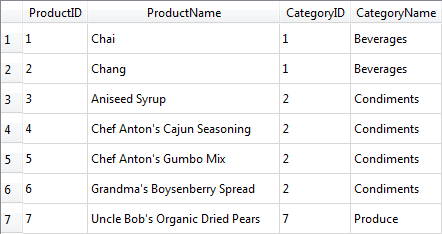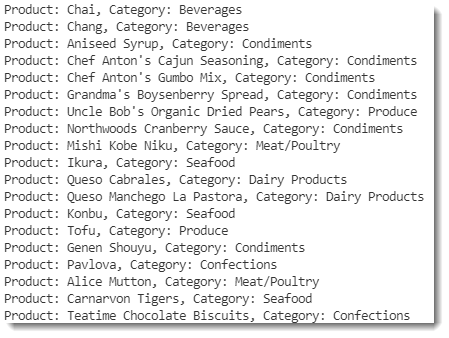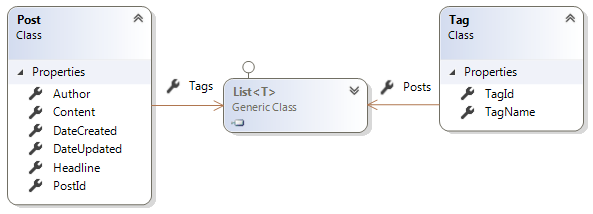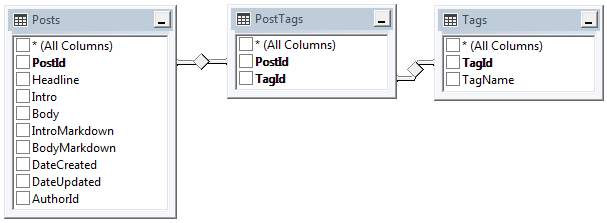Full-featured ORMs like Entity Framework Core have been designed to understand and work with relationships. EF Core will ensure that any retrieved data is automatically mapped to the appropriate association or navigational property if a related entity is included as part of a query.
- In SQL, you have a choice in how you go about retrieving related data.
- You can either perform one query to obtain all the data (a standard
JOINquery), or you can perform multiple queries, one to get the parent data, and another to obtain related data. - For most scenarios, executing a
JOINquery is likely the right choice. - Each record returned from a
JOINquery will include data from multiple objects.
Dapper Relationships
Dapper provides a feature called multi-mapping to map data to multiple objects explicitly and nested objects. As a result, Dapper is an excellent tool for managing relationships between entities within your database that can be used to retrieve related data from the database.
- It supports both synchronous and asynchronous operations, allowing you to use it in various scenarios.
- Using Dapper, you can easily execute stored procedures, map results to strongly typed objects or dynamic objects, and execute bulk CRUD operations.
- Dapper provides extension methods that enable us to perform queries on nested objects without having to write separate SQL statements for each object.
- For example, you can select from multiple tables in a single Dapper query.
- This makes it easier and faster to retrieve related entities without having to write complex SQL statements.
Dapper SplitOn
Dapper supports multi-mapping, which allows you to map a single row to multiple objects. This is helpful if you need to retrieve data from multiple tables in a single query.
- To do this, we need to use the Dapper
splitOnparameter when calling theQuerymethod. - The
splitOnparameter tells Dapper what column(s) to use to split the data into multiple objects.
using(var connection = new SqlConnection(connectionString))
{
var sql = @"SELECT ProductID, ProductName, p.CategoryID, CategoryName
FROM Products p
INNER JOIN Categories c ON p.CategoryID = c.CategoryID";
var products = await connection.QueryAsync<Product, Category, Product>(sql, (product, category) => {
product.Category = category;
return product;
},
splitOn: "CategoryId" );
products.ToList().ForEach(product => Console.WriteLine($"Product: {product.ProductName}, Category: {product.Category.CategoryName}"));
Console.ReadLine();
}
The splitOn argument tells Dapper to split the data on the CategoryId column. Anything up to that column maps to the first parameter Product, and anything else from that column onward should be mapped to the second input parameter Category.
Dapper One-To-Many Relationships
One-to-many relationships are very common in software development. For example, it defines relationships between two entities where one entity has a primary key, and the other contains foreign keys.
The following class definitions represent a cut-down version of the Product and Category entities from the canonical Northwind sample database:
public class Product
{
public int ProductID { get; set; }
public string ProductName { get; set; }
...
public Category Category { get; set; }
}
public class Category
{
public int CategoryID { get; set; }
public string CategoryName { get; set; }
...
public ICollection<Product> Products { get; set; }
}
There is an association between the Product and Category classes, represented by the Category property in the Product class and the Products property in the Category class. This means a one-to-many relationship. A product can have one category, and a category can have many products.

The following example shows an SQL query that retrieves the category related to each product from the Northwind database:
SELECT ProductID, ProductName, p.CategoryID, CategoryName
FROM Products p
INNER JOIN Categories c ON p.CategoryID = c.CategoryID
When this SQL is executed, the category information is included with each product:

That is how Dapper can execute that query to map multiple products in one pass:
using(var connection = new SqlConnection(connectionString))
{
var sql = @"SELECT ProductID, ProductName, p.CategoryID, CategoryName
FROM Products p
INNER JOIN Categories c ON p.CategoryID = c.CategoryID";
var products = await connection.QueryAsync<Product, Category, Product>(sql, (product, category) => {
product.Category = category;
return product;
},
splitOn: "CategoryID" );
products.ToList().ForEach(product => Console.WriteLine($"Product: {product.ProductName}, Category: {product.Category.CategoryName}"));
Console.ReadLine();
}
When the code above is executed, the products are output along with their related categories:

Multi-mapping is implemented as a Func generic delegate. There are overloads to the Query and QueryAsync methods that take multiple generic parameters and a Func<TFirst, ..., TReturn> map argument. The last parameter represents the return type, while the others are input parameters to be processed within the body of the Func delegate, which is a mapping function. The mapping function specifies how the resulting data should be mapped to the return type.
In this example, the input parameters are Product and Category, and the return type is Product (<Product, Category, Product>). So we are telling the QueryAsync method to take a product and a category, process them in some way to be defined and return a product.
The mapping function in this instance is quite clear:
(product, category) => {
product.Category = category;
return product;
}
Dapper maps data to the first type in the same way as it does if only one generic parameter has been supplied to the QueryAsync<T> method. It is then told to map data to the Category type and to assign the resulting object to the product's Category property.
How does Dapper identify a Category object from the data? Notice the splitOn argument? That tells Dapper to split the data on the CategoryId column. Anything up to that column maps to the first parameter (the Product), and anything else from that column onward should be mapped to the second input parameter (the Category).
Dapper Many To Many Relationships
Multiple mapping also works with many-to-many relationships. The following diagram shows a many-to-many relationship between the Post entity and a Tag entity in a model relating to a Blog application:

That is how the associations are represented in the code:
public class Tag
{
public int TagId { get; set; }
public string TagName { get; set; }
public List<Post> Posts { get; set; }
}
public class Post
{
public int PostId { get; set; }
public string Headline { get; set; }
public string Content { get; set; }
public Author Author { get; set; }
public List<Tag> Tags { get; set; }
}
The Tag class has a collection property representing many posts, and the Post class includes a collection property representing many tags.
Many-to-many relationships are represented in the database schema as a separate JOIN table:

The following SQL retrieves the tag information related to each post:
SELECT p.PostId, Headline, t.TagId, TagName
FROM Posts p
INNER JOIN PostTags pt ON pt.PostId = p.PostId
INNER JOIN Tags t ON t.TagId = pt.TagId
A row is returned for each tag, resulting in duplication of post information:

You use multi-mapping to populate both entities in the same way as previously, but this time, you use a grouping function on the result to combine the duplicate post instances and the tags:
using(var connection = new SqlConnection(connectionString))
{
var sql = @"SELECT p.PostId, Headline, t.TagId, TagName
FROM Posts p
INNER JOIN PostTags pt ON pt.PostId = p.PostId
INNER JOIN Tags t ON t.TagId = pt.TagId";
var posts = await connection.QueryAsync<Post, Tag, Post>(sql, (post, tag) => {
post.Tags.Add(tag);
return post;
}, splitOn: "TagId");
var result = posts.GroupBy(p => p.PostId).Select(g =>
{
var groupedPost = g.First();
groupedPost.Tags = g.Select(p => p.Tags.Single()).ToList();
return groupedPost;
});
foreach(var post in result)
{
Console.Write($"{post.Headline}: ");
foreach(var tag in post.Tags)
{
Console.Write($" {tag.TagName} ");
}
Console.Write(Environment.NewLine);
}
}
Then the tags (highlighted in yellow) are output along with the post headline:

Dapper Multiple Relationships
The multi-mapping works with multiple relationships. In this example, the author's detail is included in the query to be executed against the database:
SELECT p.PostId, Headline, FirstName, LastName, t.TagId, TagName
FROM Posts p
INNER JOIN Authors a ON p.AuthorId = a.AuthorId
INNER JOIN PostTags pt ON pt.PostId = p.PostId
INNER JOIN Tags t ON t.TagId = pt.TagId
The multi-mapping function takes an additional input parameter representing the extra entity being retrieved:
using(var connection = new SqlConnection(connectionString))
{
var sql = @"SELECT p.PostId, Headline, FirstName, LastName, t.TagId, TagName
FROM Posts p
INNER JOIN Authors a ON p.AuthorId = a.AuthorId
INNER JOIN PostTags pt ON pt.PostId = p.PostId
INNER JOIN Tags t ON t.TagId = pt.TagId";
var posts = await connection.QueryAsync<Post, Author, Tag, Post>(sql, (post, author, tag) => {
post.Author = author;
post.Tags.Add(tag);
return post;
}, splitOn: "FirstName, TagId");
var result = posts.GroupBy(p => p.PostId).Select(g =>
{
var groupedPost = g.First();
groupedPost.Tags = g.Select(p => p.Tags.Single()).ToList();
return groupedPost;
});
foreach(var post in result)
{
Console.Write($"{post.Headline}: ");
foreach(var tag in post.Tags)
{
Console.Write($" {tag.TagName} ");
}
Console.Write($" by {post.Author.FirstName} {post.Author.LastName} {Environment.NewLine}");
}
}
